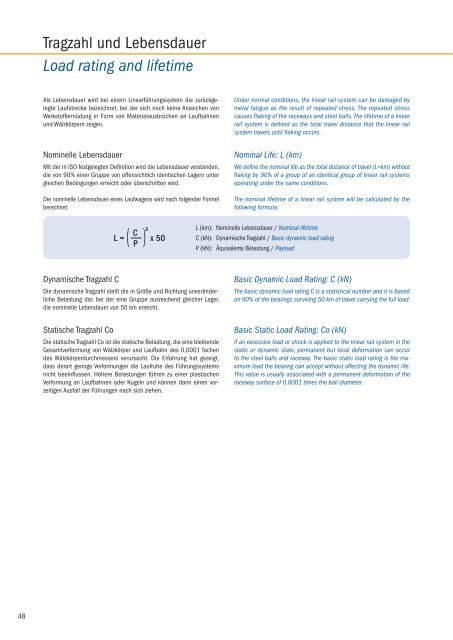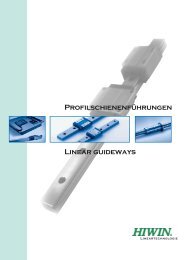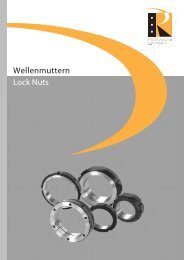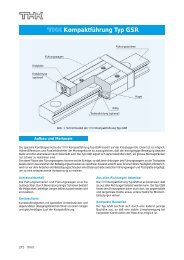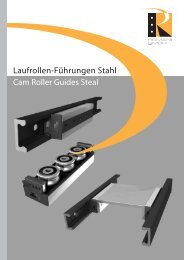Linear Rail System SBI… - Romani GmbH
Linear Rail System SBI… - Romani GmbH
Linear Rail System SBI… - Romani GmbH
Erfolgreiche ePaper selbst erstellen
Machen Sie aus Ihren PDF Publikationen ein blätterbares Flipbook mit unserer einzigartigen Google optimierten e-Paper Software.
48<br />
Tragzahl und Lebensdauer<br />
Load rating and lifetime<br />
Als Lebensdauer wird bei einem <strong>Linear</strong>führungssystem die zurückgelegte<br />
Laufstrecke bezeichnet, bei der sich noch keine Anzeichen von<br />
Werkstoffermüdung in Form von Materialausbrüchen an Laufbahnen<br />
und Wälzkörpern zeigen.<br />
Nominelle Lebensdauer<br />
Mit der in ISO festgelegten Definition wird die Lebensdauer verstanden,<br />
die von 90% einer Gruppe von offensichtlich identischen Lagern unter<br />
gleichen Bedingungen erreicht oder überschritten wird.<br />
Die nominelle Lebensdauer eines Laufwagens wird nach folgender Formel<br />
berechnet:<br />
Dynamische Tragzahl C<br />
C ³<br />
L = ( ) x 50<br />
P<br />
Die dynamische Tragzahl stellt die in Größe und Richtung unveränderliche<br />
Belastung dar, bei der eine Gruppe ausreichend gleicher Lager,<br />
die nominelle Lebendauer von 50 km erreicht.<br />
Statische Tragzahl Co<br />
Die statische Tragzahl Co ist die statische Belastung, die eine bleibende<br />
Gesamtverformung von Wälzkörper und Laufbahn des 0,0001 fachen<br />
des Wälzkörperdurchmessers verursacht. Die Erfahrung hat gezeigt,<br />
dass derart geringe Verformungen die Laufruhe des Führungssystems<br />
nicht beeinflussen. Höhere Belastungen führen zu einer plastischen<br />
Verformung an Laufbahnen oder Kugeln und können dann einen vorzeitigen<br />
Ausfall der Führungen nach sich ziehen.<br />
Under normal conditions, the linear rail system can be damaged by<br />
metal fatigue as the result of repeated stress. The repeated stress<br />
causes flaking of the raceways and steel balls. The lifetime of a linear<br />
rail system is defined as the total travel distance that the linear rail<br />
system travels until flaking occurs.<br />
Nominal Life: L (km)<br />
We define the nominal life as the total distance of travel (L=km) without<br />
flaking by 90% of a group of an identical group of linear rail systems<br />
operating under the same conditions.<br />
The nominal lifetime of a linear rail system will be calculated by the<br />
following formula:<br />
L (km): Nominelle Lebensdauer / Nominal lifetime<br />
C (kN): Dynamische Tragzahl / Basic dynamic load rating<br />
P (kN): Äquivalente Belastung / Payload<br />
Basic Dynamic Load Rating: C (kN)<br />
The basic dynamic load rating C is a statistical number and it is based<br />
on 90% of the bearings surviving 50 km of travel carrying the full load.<br />
Basic Static Load Rating: Co (kN)<br />
If an excessive load or shock is applied to the linear rail system in the<br />
static or dynamic state, permanent but local deformation can occur<br />
to the steel balls and raceway. The basic static load rating is the maximum<br />
load the bearing can accept without affecting the dynamic life.<br />
This value is usually associated with a permanent deformation of the<br />
raceway surface of 0.0001 times the ball diameter.


